Introduction
Vegetables generally contain many antioxidants, including vitamin C, carotenoids, anthocyanin, and flavonoids,1 which can reduce the number of free radicals and the potentialrisk of developing carcinogenic diseases. Consuming antioxidants from natural foods such as vegetables is a good way to prevent cardiovascular diseases, especially arteriosclerosis.2 Lettuce is widely consumed fresh in salad and other dishes. In its fresh state, lettuce contains vitamin C of around 3.9 mg/100g 3 and anthocyanins of around 351.3 µg/g.4 Currently, the global population is increasing, while the availability of agricultural land is decreasing. To meet nutritional needs, it is necessary to improve the agricultural properties of vegetables or fruits to increase the nutritional content and bioactive compounds that are useful for human health. Effective cultivation management strategies can help plants become more resistant to microbes, enhance their tolerance to environmental stress, increase production yields,5 and elevate the active biomolecule content.6
Various methods have been used to increase the productivity and nutritional content of vegetables or fruits, some of which are organic or inorganic fertilization, biofortification, nanotechnology, and others. The application of a nitrogen fertilizer at a dose of 60 kg Nha-1 resulted in increased levels of calcium and magnesium in cherry leaves, while at a dose of 120 kg Nha−1, the levels decreased.7 However, the inappropriate use of mineral fertilizers in many productive soils has decreased their ability to function.8 When using litter compost with livestock manure at a rate of 25 Mg ha-1 combined with nitrogen fertilizer, there was an increase in the fresh weight and the number of leaves per mustard plant. Conversely, there was no significant difference without the addition of nitrogen fertilizer.9 However, it is worth noting that the use of organic fertilizers generally requires large amounts to achieve the desired effect;10,11 moreover, it involves significant labor investment, and the quality still needs improvement.12 Biofortification aims to increase the concentration of nutrients in food, 13 which is beneficial for human health,14 but it often comes with high costs, and the availability of biofortified foods is generally limited.15 The unutilization of nanotechnology in agriculture is highly expensive, making it difficult for farmers to access.16 Meanwhile, the use of microbial fertilizers (MFs) is a cost-effective and environmentally friendly method.
Several studies have shown that treatment with MFs can increase plant tolerance to biotic (living)17 and abiotic (dead) 18 stresses, resulting in observable responses from their activation.19 Research using MFs in plants has been carried out using various MFs, including low-frequency, static, and pulsed MFs. 20 For example, Shabrangi & Majd 21 used a static MF with an intensity of 0.1 mT, while Iqbal et al.22 applied MFs with low frequencies, specifically MFs of 60 mT and 180 mT. However, no research has yet reported the frequency of MFs that can optimize plant growth, productivity, and antioxidant content. It has been reported that the cell membranes of biological systems contain both positive and negative ions, thereby generating electric fields in and around the cell membrane.23 It was further revealed that external MFs could interact resonantly with the internal electric fields of biological systems, 24 suggesting the potential for significant impacts on red lettuce plants’ growth, productivity, and antioxidant content. Given these findings, this research aims to identify a MF frequency that can optimize plant growth, productivity, and the content of anthocyanin, vitamin C, and flavonoids.
Materials and Methods
Sample preparation
In this study, samples of red lettuce seeds produced by PT Bisi International Tbk- Indonesia were utilized. Seeds of nearly uniform size were selected for the experiement. These seeds were divided into six groups, each containing ten seeds. The seeds were initially soaked in water for 10 minutes and then placed on cotton that had been moistened.
Research tool design
In this study, an alternating MF was employed as a research tool. The MF was generated using a solenoid coil, which was connected to an alternating current source in the form of a sinusoid of the frequency audio generator. The solenoid was made of copper wire measuring 1.0 mm and consists of 216 turns. The solenoid had a radius of 2 cm. In its implementation, the solenoid is connected to a frequency audio generator, and the seeds are placed in the middle of the solenoid (Figure 1). Once assembled, the audio frequency generator was activated by selecting a sinusoidal voltage source. The current and frequency were adjusted in such a way as to produce an effective MFD of 0.4 mT. The MFD was measured using a Kanetec TM801 Tesla Meter.
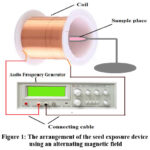 |
Figure 1: The arrangement of the seed exposure device using an alternating magnetic field. |
Exposure to magnetic fields
The seeds, which had been moistened and placed in cotton, were exposed to an alternating MF with an effective flux density of 0.4 mT and a different frequency according to the group. The MF frequency used was 0 -125 Hz with an exposure time of 15 minutes each, repeated daily for up to five days. Exposure to MFs was conducted at the Biophysics Laboratory of Maulana Malik Ibrahim State Islamic University, Malang.
Seeding and planting
Seeding was conducted in polybags measuring 6 x 6 cm filled with a mixture of husk charcoal and sand in a ratio of 1: 1, with a depth of 4 cm. The seeds sown in polybags were watered twice daily, every morning and evening. Seedlings were initially grown in nursery polybags, and at 15 days of age, were transferred into larger 25 cm x 25 cm polybags. Plants in these polybags were watered every morning. The planting took place in the Green House of the Maulana Malik Ibrahim State Islamic University, Malang under environmental environmental conditions featuring a temperature range of 21-30oC and air humidity levels of 70-85%
Determination of anthocyanin content
To determine the anthocyanin content of lettuce leaves, the pH-differentiation method was employed.25,26 The measurements were taken on the third leaf from the top when the plants were 38 days old. The leaves were thoroughly mashed until they released liquid, and then as much as 10 grams of this liquid were collected in a Duran brand Erlenmeyer. To this liquid, 25 ml of 1% HCl (Brand of Merck- Supelco) solution was added. The solution was macerated for 1 minute and then shaken for 5 minutes. Subsequently, it was filtered and then placed in a test tube, covered with aluminum foil and left in the refrigerator for 24 hours. The samples that had precipitated or cooled were returned to room temperature for 2 hours. The samples were divided into two parts, each measuring 0.2 ml . The first part was added with a 4.8 buffer solution at pH 1.0, while the second part was added with a 4.8 buffer solution at pH 4.5. These mixtures were homogenized using a vortex (Brand of D-LAB; MX-S Type). Absorption measurements were carried out at wavelengths of 400 nm and 700 nm using a Phywe P3070101 UV-Vis spectrometer. The absorbance determination of the dissolved sample (A) was carried out using equation (1).

Meanwhile, the determination of the anthocyanin content was carried out using equation (2)

where: A = absorbance, l = cuvette thickness (1 cm), Ԑ = molar absorptivity (26900 L/(mol.cm)), FP = dilution factor, BM = molecular weight (449.2 g/mol).
Determination of vitamin C content
Vitamin C content was measured using a Phywe P3070101 UV-Vis spectrometer.27 This analysis was conducted on lead samples taken the third position from teh top, collected when the plants were 38 days old. To establish as standard reference, ascorbic acid was prepared as a standard solution by dissolving 50 mg of ascorbic acid in 100 ml of distilled water to form a solution with a concentration of 500 µg/ml. The maximum wavelength was determined using a solution with a concentration of 7 µg/ml, and measurements were taken at a wavelength of 200-400 nm; 28 the results were obtained at a wavelength of 265 nm. For the calibration of vitamin C measurements, a calibartion curve was made using various concentrations, namely 3,5,7,9, and11 µg/ml. This calibration curve was generated from the measurement results, yielding a regression equation,

where x is the concentration of vitamin C, while y is the absorbance.
To prepare the extract 10 g of finely ground sample were mixedwith 50 ml of 5% metaphosphoric acid acetic acid (Brand of Merck–Supelco) solution. Subsequently, the mixture was transferred to a conical flask, to which 50 ml of phosphoric acid solution was added. Then, the resulting solution was then filtered using Whatman filter paper. The filtrate obtained from this process was collected to determine the vitamin C content. The vitamin C concentration was calculated using equation (3).
Determination of flavonoid content
The determination of total flavonoid content was performed using a Phywe P3070101 UV-Vis spectrometer.29 For this analysis, aluminum chloride was used as a reagent, while quercetin was used as the comparator compound used. 30 Sample preparation was conducted by dissolving 0.5 ml of extract solution with a concentration of 200 μg/ml in 1.5 mL of ethanol. Then, 0.1 ml of 10% AlCl3 and 0.1 mL of 1M potassium acetate were added to the solution. The mixture was subsequently diluted to a total volume of 10 mL using distilled water and allowed to stand for 30 minutes at room temperature. The absorbance of the mixed solution was measured using a UV-Vis spectrometer at a wavelength of 428 nm.
Statistical analysis
Statistical analysis involved the use of analysis of variance (ANOVA) to examine the significance of the effect of changes in MF frequency on growth, plant weight, and the content of anthocyanin, vitamin C, and flavonoids. Subsequently, if a significant effect was found, The Duncan Multiple Range test was applied to determine the significance of differences between treatments. All statistical analysis was conducted using SPSS Version 20.
Results
Plant height growth
Plant height growth was measured from the time of transfer to polybags until the plants reached 38 days old. Growth was determined by calculating the difference between the height of plants aged 38 days and the height of control plants aged seven days. Notably, plants experienced varying height growth in each treatment in response to different MF frequencies (Figure 2). Optimum growth was observed in plants exposed to a MF with a frequency of 75 Hz. In the absence of exposure to a MF (control), the growth measured 10.56 ± 0.92 cm. However, when exposed to a MF with a frequency of 75 Hz, the growth increased to 17.44±1.31 cm or an increase of 65.15%. Exposure to a frequency of 50 Hz resulted in lower plant growth compared to exposure to a frequency of 25 Hz, with plant growth measuring 13.08±1.17 cm for 50Hz and 12.7±0.35 cm for 25 Hz. Likewise, exposure to a frequency of 100 Hz resulted in lower growth than exposure to a frequency of 125 Hz, namely 14.76 ± 0.60 cm and 16.26 ±1.50 cm, respectively.
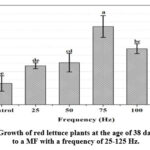 |
Figure 2: Growth of red lettuce plants at the age of 38 days exposed to a MF with a frequency of 25-125 Hz. |
Plant weight
Lettuce plant weight, excluding the roots, was measured immediately after harvest from the field when the plants were 38 days old. The measurement results showed that the frequency of exposure to the MF affected the weight of the lettuce plants (Figure 3). The largest weight was obtained by plants exposed to a MF with a frequency of 75 Hz, measuring 129.19 ± 0.61 grams, representing a substantial increase of 60.18% compared to no exposure to MF (control), which had a weight of 80.65 ± 0.67 cm. In contrast, exposure to a frequency of 100 Hz resulted in a lower weight than exposure to a frequency of 75 and 125 Hz, measuring 116.42 ± 0.91 grams. Plants exposed to a frequency of 125 Hz had a weight of 125.2 ± 0.79 grams. The results of the statistical analysis showed that changes in the MF frequency significantly (p £0.05) affected the weight of the lettuce plants produced.
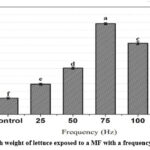 |
Figure 3: Fresh weight of lettuce exposed to a MF with a frequency of 25-125 Hz. |
Anthocyanin content
Red lettuce leaves exhibit a variety of colors, including red, green, and yellow. Measurements were taken by mixing all the colors found on the third leaf from the top. The measurement results show that the frequency of exposure to the MF affects the anthocyanin content. The highest levels of anthocyanins were observed in plants exposed to a MF frequency of 100 Hz, measuring 18.67 ± 0.69 mg/L, an increase of 22.52% compared to the control group, which had no exposure to a MF , measuring15.24 ± 0.87 mg/L (Figure 4). Conversely, exposure to a higher MF frequency, 125 Hz, resulted in anthocyanin content lower than 100 Hz, measuring 17.93 ± 0.69 mg/L. The results of statistical analysis showed that the 50-125 Hz MF frequencies had a significant effect (p£0.05) on the anthocyanin content of the red lettuce leaves.
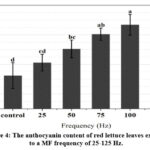 |
Figure 4: The anthocyanin content of red lettuce leaves exposed to a MF frequency of 25-125 Hz. |
Vitamin C content
The use of an alternating MF during the seeding red lettuce plants affects the vitamin C content in the leaves as they grow. Exposure to an alternating MF with an effective MFD of 0.4 mT and a frequency of 25-125 Hz led to increased vitamin C content compared to plants without exposure. Different frequencies of MF used for exposure resulted in varying vitamin C contents in red lettuce leaves (Figure 5). The highest vitamin C content was observed in plants exposed to a MF frequency of 100 Hz. Exposure using an M F frequency of 100 Hz increased the vitamin C content by 40.70% compared to no exposure. The vitamin C content of lettuce leaves without MF exposure measured 6.64 ± 0.61 mg/100gm, while exposure to a MF frequency of 100 Hz measured 9.35 ± 1.36 mg/100gm. In contrast, exposure to a frequency of 125 Hz yielded a lower vitamin C content than that of 100 Hz, measuring 8.93 ± 0.47 mg/100gm. The results of statistical analysis found that exposure to MF frequencies of 75-125 Hz had a significant effect (p £0.05) on the vitamin C content of red lettuce leaves.
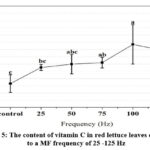 |
Figure 5: The content of vitamin C in red lettuce leaves exposed to a MF frequency of 25 -125 Hz |
Flavonoid content
Flavonoids are antioxidants and are found in many plants, including red lettuce. The content of flavonoids in red lettuce can be changed by exposing it to an alternating MF during seeding. The flavonoid content in red lettuce exposed to alternating MF changes depending on the frequency of MF used (Figure 6). The highest flavonoid content was found in plants exposed to a frequency of 100 Hz, measuring 10.60 ± 1.175 mgQE/g, while those without exposure had a content of 7.99 ± 0.58 mgQE/g, representing an increase of 32.50%. Exposure to a MF with a frequency of 125 Hz resulted in a lower flavonoid content compared to 100 Hz, measuring 9.83 ± 1.23 mgQE/g, while at frequencies of 25, 50, and 75 Hz, the flavonoid content measured 8.19±0.63 mgQE/g, 8.54±0.49 mgQE/g, and 8.53±1.01 mgQE/g, respectively. The results of the statistical analysis showed a significant effect when exposed to frequencies of 100 Hz and 125 Hz compared to no exposure to a magnetic field.
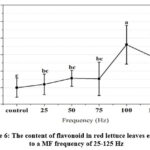 |
Figure 6: The content of flavonoid in red lettuce leaves exposed to a MF frequency of 25-125 Hz. |
Discussion
Exposure to an alternating MF with an effective MFD of 0.4 mT and a frequency of 25-125 Hz during the growth of red lettuce seeds affected the growth, productivity, and the content of anthocyanin, vitamin C, and flavonoid . Meanwhile, the changes in anthocyanin, vitamin C, and flavonoid content were directly proportional to the frequencies of 25-100 Hz, while the 100-125 Hz frequency showed an inverse relationship (Table 1). This suggests that changes in the MF frequency do not linearly affect the productivity and content of anthocyanins, vitamin C, and flavonoids. Similar findings have also been reported by Usanov et al. 31 and Wójcik-Piotrowicz et al.32
Table 1: Percentage increase in plant growth, fresh weight, and content of anticyanins, vitamin C, and flavonoids on exposure to a magnetic field frequency of 25-125 Hz
|
Magnetic field |
Increase (%) |
||||
|
frequency (Hz) |
plant growth |
fresh weight |
anthocyanin |
vitamin C |
flavonoid |
|
content |
content |
content |
|||
|
25 |
20.27 |
11.26 |
5.75 |
16.77 |
2.50 |
|
50 |
23.86 |
24.33 |
11.82 |
20.18 |
7.09 |
|
75 |
65.15 |
60.18 |
18.37 |
21.84 |
6.67 |
|
100 |
39.77 |
44.35 |
22.52 |
40.70 |
32.50 |
|
125 |
53.98 |
55.23 |
17.65 |
34.36 |
22.92 |
Exposure to seeds using a MF with a changing MFD can lead to the induction of currents and electric fields.33 These induced electric fields and currents have the potential to change the behavior of biological systems, given that living things depend on electrical signaling and charge flow. 23 Furthermore, magnetic fields have been shown to directly affect ion channels in cells.34 It was also revealed that exposure to magnetic fields with changing flux densities could result in changes in the dielectric and acoustic properties of the aqueous medium, which correlated with changes in several characteristics of chemical and biological systems.31 MFs have the capacity to polarize the water atoms, leading to changes in the physicochemical properties of water.35 Such changes in the physicochemical properties of water, both inside and outside the cells, will affect the activities of the cellular metabolism of organisms.The extent of the influence of the MF depends on the frequency used. MFs with resonant frequencies have the potential to affect the photosynthesis process; however, the magnitude of this varies among different plant species.36 The probability of Brownian motion occuring in plant seeds is influenced by the Lorentz force generated by the MF, and the magnitude of this effect depends on the relationship between the Larmor frequency and dynamic friction.37 Furthermore, magnetic fields can interact resonantly with endogenous alternating electric fields in biological systems.24 As a result, changes in the MF frequency have a non-linear effect on the height and weight of red lettuce and also affect plant physiology. Notably, plant physiology shows that the color of plant leaves becomes greener when exposed to a MF with a frequency of 25-75 Hz, while the opposite occurs at a frequency of 75-125 Hz (Figure 7).
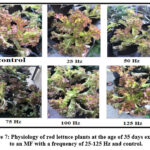 |
Figure 7: Physiology of red lettuce plants at the age of 35 days exposed to an MF with a frequency of 25-125 Hz and control. |
Exposure to a MF on seeds will produce pairs of spin-correlated free radicals that are chemically and biologically influential.38 One form of free radicals is Reactive Oxygen Species (ROS), which affect several physiological processes in living things.39 The formation of ROS can induce the oxidative degradation of cytotoxic lipids because they initiate a chain reaction in the cell membrane.40 This condition increases the production of proline to protect the osmolyte compound.41 Thus, the cellular structure is strengthened by lowering the osmotic potential, retaining proteins from denaturation, and reducing ROS levels.42 Another potential mechanism of action involved an increase in the activity of certain enzymes, which is a biological response to MF exposure. Antioxidant storage mechanisms can be used to scavenge excess ROS.43 This system that suppresses ROS with antioxidants consists of enzymatic and non-enzymatic components that function across various partitions of the subcellular.44 ROS scavenging can be assisted by complementary agents consisting of non-enzymatic antioxidants, which can be obtained by exposure to a magnetic field. Therefore, exposure to magnetic fields can affect the content of anthocyanin, vitamin C, and flavonoids in red lettuce leaves.
Exposure to an alternating magnetic field with an extra low frequency and a magnetic flux density of 0.4 mT principally affects human cell growth.45,46 It may cause health problems if used over a long time. Using a solenoid coil makes the magnetic flux density of 0.4 mT localized on the inner solenoid axis (Figure 1), while the outer part is small and tends to zero. Therefore, exposure using the magnetic field generated by the solenoid is safe for the user and the environment. Using a magnetic field with a magnetic flux density of 0.4 mT requires a current flow of ~0.15 A for 15 minutes per exposure. Therefore, low electrical energy is required so that economically, it requires low electricity costs.
Conclusion
Exposure to an alternating MF on seeds affects water content and electrical signaling, and it can generate free radicals. As a result, it affects the growth, productivity and content of red lettuce leaves. Optimum growth and productivity were obtained with exposure to a MF frequency of 75 Hz, while anthocyanin, vitamin C, and flavonoid content were maximized at 100 Hz. It is worh noting that the effect of MF frequency on growth, productivity, and the content of anthocyanin, vitamin C, and flavonoids is not linear; instead, it is influenced by resonant frequencies, which determined the extent of the observed effects.
Acknowledgment
Thanks to Prof. Abdul Rohman for the corrections and directions to improve the article.
Conflicts of Interest
Authors declare no conflicts of interest.
Funding Sources
Funding was obtained from the Maulana Malik Ibrahim State Islamic
University of Malang with Chancellor’s Decree Number 354 of 2022.
References
- Bogdanovic J., Bogdanović-Pristov J., Maksimović V. Phenolic compounds and vitamin C as sources of antioxidant activity in black Phenolic compounds and vitamin C as sources of antioxidant activity in black currant fruit (Ribes nigrum L .). Acta Agriculturae Serbica. 2010;15(29):3-10.
- Hu F.B. Dietary pattern analysis : a new direction in nutritional epidemiology. Current Opinion in Lipidology. 2002;13:3–9.
CrossRef - Hassan M.N., Mekkawy S.A., Mahdy M., Salem, K.F.M. Recent molecular and breeding strategies in lettuce ( Lactuca spp .). Genetic Resources and Crop Evolution.2021; 68:3055–3079.
CrossRef - Gazula A., Kleinhenz M.D., Scheerens J.C., Ling P.P. Anthocyanin Levels in Nine Lettuce ( Lactuca sativa ) Cultivars : Influence of Planting Date and Relations among Analytic, Instrumented, and Visual Assessments of Color. Hortscience. 2007;42(2): 232–238.
CrossRef - Taylor P., Ichikawa Y., Tamoi M., Sakuyama H., Maruta T., Ashida H., Yokota A. Generation of transplastomic lettuce with enhanced growth and high yield. GM Crops. 2010;1(5): 1–6. https://doi.org/10.4161/gmcr.1.5.14706
CrossRef - Cheng D.M., Pogrebnyak N., Kuhn P., Krueger C.G., Johnson W.D., Raskin I. Development and Phytochemical Characterization of High Polyphenol Red Lettuce with Anti-Diabetic Properties. Plos one. 2014;9(3): 1–10. https://doi.org/10.1371/journal.pone.0091571
CrossRef - Rutkowski K., Łysiak G.P. Effect of Nitrogen Fertilization on Tree Growth and Nutrient Content in Soil and Cherry Leaves ( Prunus cerasus L .). agriculture. 2023;13(578):1-23..
CrossRef - Krasilnikov P., Taboada M.A. Fertilizer Use, Soil Health and Agricultural Sustainability. Agriculture. 2022;12(462):1–5.
CrossRef - Muktamar Z., Putri D., Setyowati N. Reduction of Synthetic Fertilizer for Sustainable Agriculture : Influence of Organic and Nitrogen Fertilizer Combination on Growth and Yield of Green Mustard. Int J Adv Sci Eng Inf Technol. 2016;6(3):361–364
CrossRef - Gao F., Li H., Mu X., Gao H., Zhang Y., Li R., Cao K., Ye L. Applied sciences Effects of Organic Fertilizer Application on Tomato Yield and Quality : A Meta-Analysis. Applied sciences. 2023;13(2184):1-17
CrossRef - Tabaxi I., Ζisi C., Karydogianni S., Folina A.E., Kakabouki I., Kalivas A. Bilalis D. Effect of organic fertilization on quality and yield of oriental tobacco (Nicotiana tabacum L.) under Mediterranean conditions. Asian J. Agric. Biol. 2021;1:1-7. DOI: https://doi.org/10.35495/ajab.2020.05.274
CrossRef - Husain N. A. Critical study on the use, application and effectiveness of organic and inorganic fertilizers. Jr. of Industrial Pollution Control. 2019;30(2):191:194.
- Anwar Z., Basharat Z., Hafeez M.B., Khan S., Zahra N., Rafique Z., Maqsood M. Biofortification of maize with zinc and iron not only enhances crop growth but also improves grain quality. Asian J. Agric. Biol. 2022;(2):1-9. https://doi.org/10.35495/ajab.2021.02.079
CrossRef - Marques E., Darby H.M., Kraft J. Benefits and Limitations of Non-Transgenic Micronutrient Biofortification Approaches. Agronomy. 2021;11(464):1-14.
CrossRef - Sonntag A. Global Hunger Index: The challenge of hidden hunger. International Food Policy Research Institute. 2014. https://doi.org/10.2499/9780896299580
CrossRef - Kumar A., Gupta K., Dixit S., Mishra K. Srivastava S. A review on positive and negative impacts of nanotechnology in agriculture. International Journal of Environmental Science and Technology . 2018;17(November):1-13.
- Araújo S.D.S., Paparella S., Dondi D., Bentivoglio A., Carbonera D., Balestrazzi A. Physical Methods for Seed Invigoration : Advantages and Challenges in Seed Technology. Frontiers in Plant Science. 2016;7(646):1–12. https://doi.org/10.3389/fpls.2016.00646
CrossRef - Ouhibi C., Attia H., Rebah F., Msilini N., Chebbi M., Aarrouf J., Urban L., Lachaal M. Plant Physiology and Biochemistry Salt stress mitigation by seed priming with UV-C in lettuce plants : Growth , antioxidant activity and phenolic compounds. Plant Physiology et Biochemistry. 2014;30:1–8. https://doi.org/10.1016/j.plaphy.2014.07.019
CrossRef - Bhardwaj J., Anand A., Nagarajan S. Plant Physiology and Biochemistry Biochemical and biophysical changes associated with magnetopriming in germinating cucumber seeds. Plant Physiology et Biochemistry. 2012;57:67–73. https://doi.org/10.1016/j.plaphy/2012.05.008
CrossRef - Shine S., Kataria M.B., Anjali K.N.G. Enhancement of maize seeds germination by magnetopriming in perspective with reactive oxygen species. Journal of Agricultural and Crop Research. 2017;5(4): 66–76.
- Shabrangi A.. Majd A. Effect of magnetic fields on growth and antioxidant systems in agricultural plants. Progress in Electromagnetics Research Symposium. 2009;2:1115–1120.
- Iqbal M., Muhammad D., Zia-ul-Haq, Jamil Y., Ahmad R. Effect of pre-sowing magnetic field treatment to garden pea (Pisum sativum L.) seed on germination and seedling growth. Pakistan Journal of Botany. 2012; 44(6), 1851–1856
- Plonsey R.. Barr R. Bioelectricity AQuantitative Approach, Third Edition. New York USA. Springer Science+Business. 2007.
- Dhawi F., Al-khayri J.M., Hassan E. Static Magnetic Field Influence on Elements Composition in Date Palm ( Phoenix dactylifera L .). Research Journal of Agriculture and Biological Sciences. 2009;5(2): 161–166.
- Giust M.M., Wrolstad R.E.. Characterization and Measurement of Anthocyanins by UV-Visible Spectroscopy. Curr. protoc. food anal. chem. 2001;P.1–13.
CrossRef - Purbaningtias T.E., Aprilia A.C., Fauzi, L. The study of temperature and UV light effect in anthocyanin extract from dragon fruit ( Hylocereus costaricensis ) rind using UV- Visible spectrophotometer. AIP Conference Proceedings 1911.2017; 1–6.
CrossRef - Desai A.P., Desai S. UV Spectroscopic Method for Determination of Vitamin C ( Ascorbic Acid ) Content in Different Fruits in South Gujarat Region. Int J Environ Sci Nat Res. 2019; 21(2):41–44. https://doi.org/10.19080/IJESNR.2019.21.556056
CrossRef - Pancham Y.P., Girish B., Sanjay S.S. UV-Spectrophotometric method for quantification of ascorbic acid in bulk powder. The Pharma Innovation Journal. 2020; 9(5):5–8.
- Wulandari L., Permana B.D., Kristiningrum N. Determination of Total Flavonoid Content in Medicinal Plant Leaves Powder Using Infrared Spectroscopy and Chemometrics. Indones. J. Chem. 2020;20 (5):1044–1051. https://doi.org/10.22146/ijc.47047
CrossRef - Linn E. Determination of Total Flavonoid and Phenol Content in Mimusops Elengi Linn. Mathur and Vijayvergia. 2017;8(12): 5282-5285. https://doi.org/10.13040/IJPSR.0975-8232.8(12).5282-85
CrossRef - Usanov A.D., Belyachenko Y.A., Verkhov D.G., Tyrnov V.S., Usanov D.A. Effect of Frequency of Alternating Magnetic Field on Stimulation of Plants Meristem Mitotic Activity. Biochemistry and Biophysics (BAB). 2013;1(4): 61–65.
- Wójcik-Piotrowicz K., Kaszuba-Zwoińska J., Rokita E., Thor P., Chorobik P., Nieckarz Z., Michalski J. Influence of Static and Alternating Magnetic Fields on U937 Cell Viability. Folia Medica Cracoviensia. 2014;54(4): 21–33.
- Jakson D.J. Classical-electrodynamics-3rd-edition. Jonh Wiley & Son. 2007
- Goychuk I. Sensing Magnetic Fields with Magnetosensitive Ion Channels. Sensors. 2018; 18(728):1-19. https://doi.org/10.3390/s18030728
CrossRef - Cai R., Yang H., He J., Zhu W. The effects of magnetic fields on water molecular hydrogen bonds. J. Mol. Struct. 2009;938(1–3): 15–19. https://doi.org/10.1016/j.molstruc.2009.08.037
CrossRef - Sukhov V., Sukhova E., Sinitsyna Y., Gromova E., Mshenskaya N., Ryabkova A., Ilin N., Vodeneev V., Mareev E., Price C. Influence of Magnetic Field with Schumann Resonance Frequencies on Photosynthetic Light Reactions in Wheat and Pea. Cells. 2021;10(149):1-18.
CrossRef - Engstrom S. Physical Mechanisms of Non-Thermal Extremely-Low-Frequency Magnetic-Field Effects. The Radio Science Bulletin. 2004;1(311):95–106.
- Wang H., Zhang X. Magnetic Fields and Reactive Oxygen Species. International Journal of Molecular Sciences. 2017;18(2175):1-20. https://doi.org/10.3390/ijms18102175
CrossRef - Bardaweel S.K., Gul M., Alzweiri M., Ishaqat A. Reactive Oxygen Species : the Dual Role in Physiological and Pathological Conditions of the Human Body. Eurasian J Med. 2018;50(3): 93–201. https://doi.org/10.5152/eurasianjmed. 17397
CrossRef - Su L,. Zhang J., Gomez H., Murugan R., Hong X., Xu D., Jiang F., Peng Z. Review Article Reactive Oxygen Species-Induced Lipid Peroxidation in Apoptosis, Autophagy, and Ferroptosis. Oxidative Medicine and Cellular Longevity. 2019;1-13.
CrossRef - Latef A.A.H.A., Dawood M.F.A., Hassanpour H., Rezayian M., Younes N.A. Impact of the Static Magnetic Field on Growth, Pigments, Osmolytes, Nitric Oxide, Hydrogen Sulfide, Phenylalanine Ammonia-Lyase Activity, Antioxidant Defense System, and Yield in Lettuce. Biology. 2020;9(172):1-18.
CrossRef - Serraj R., Sinclair T.R. Osmolyte accumulation : Can It Really Help Increase Crop Yield under Drought Conditions ? Plant, Cell and Environment. 2002;25:333–341.
CrossRef - Ahmad P, Sarwat M., Sharma S. Reactive Oxygen Species , Antioxidants and Signaling in Plants. Journal of Plant Biology. 2008;51(3):167–173.
CrossRef - Irato P. Enzymatic and Non-Enzymatic Molecules with Antioxidant Function. Antioxidants. 2021;10(579):1-4.
CrossRef - Nur A.A., Suryandari D.A., Sari P.S. Effect of extremely low frequency electromagnetic field exposure on pachytene spermatocyte cell quantity in Webster strain male mice. Journal of Physics: Conference Series. 2018;1073, 1–9..
CrossRef - Marcilio I., Gouveia N., Gouveia N. Extremely low-frequency magnetic fields and health effects : literature review. Rev Bras Epidemiol. 2009; 12(2): 1-19.
CrossRef

This work is licensed under a Creative Commons Attribution 4.0 International License.






